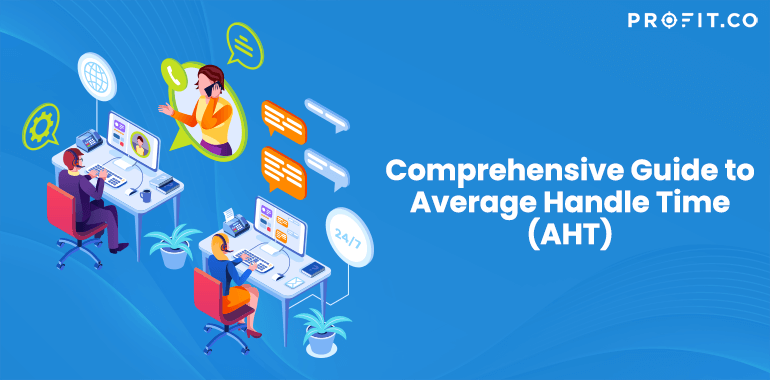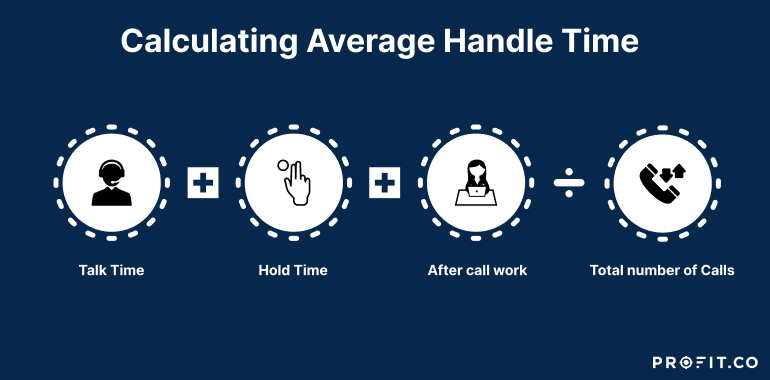Call centers are the backbone of customer support for many businesses, and understanding and optimizing performance metrics is crucial to ensure high customer satisfaction. One of the most critical performance metrics is Average Handle Time (AHT), which measures the average duration of customer interaction from the moment the customer reaches out to when the issue is resolved. This comprehensive guide will discuss AHT, why it’s an important KPI, how to calculate it, industry benchmarks, and best practices for reducing AHT while maintaining excellent customer service.
Content Index
What is Average Handle Time (AHT)?
Average Handle Time (AHT) is a call and contact center metric that measures the average duration of complete customer interaction from the moment the customer reaches out to when both the agent and customer agree the issue is resolved. AHT encompasses every phase of the customer service and support process, not just the average time an agent and customer speak on the phone (Average Talk Time).
AHT includes all time spent
- Interacting with call menus: Listening to/interacting with IVR systems, auto attendants, voicemail messages, pre-recorded automated greetings, etc.
- On hold: In a call queue, during the call transfer, call forwarding, or call routing processes, while an agent reviews customer data, listens to phone rings before a pickup, etc.
- Talking to an agent
- On follow-up tasks: Scheduling callbacks or appointments, after-call work (call notes, call disposition, CRM data entry, etc.), making follow-up calls, etc.
Average Handle Time includes calls resolved during the first call/ first contact and calls requiring one or more follow-ups.
Why is Average Handle Time Important?
AHT is crucial because it provides insight into the following
- Agent performance and current agent training materials
- The customer journey and experience
- The effectiveness of existing call management strategies like call routing, IVR menus, call paths, etc.
- Ways to improve your workforce management strategy (adjust agent schedules, hire additional agents, identify and prepare for peak call times)
- Likely causes of customer frustration (extended call hold times, a lack of good self-service options, not feeling like a priority, being connected to unhelpful agents that need more skills to resolve the issue, etc.)
- Service and support team and individual agent productivity levels, the state of agent engagement, and shared support topics
Start tracking your KPIs today with Profit.co
How to Calculate Average Handle Time?
To calculate Average Handle Time, choose the time (one day) you want to measure and add up total talk time, total hold time, and total after-call work time for that period. Then, divide that sum by the total number of calls (or other customer conversations) during the same period to get your Average Handle Time.
Formula
Refer to the following example, to find a daily Average Handle Time for a call center
A total daily talk time of 1,500 minutes, A total daily hold time of 2,200 minutes, A total after-call work time of 3,000 minutes with 250 total daily customer conversations
Step 1: Add: 1,500 + 2,200 + 3,000 = 6,700
Step 2: Divide 6,700 / 250 = 26.8
The call center has an AHT of 26.8 minutes per call
A good Average Handle Time is about 6 minutes per call or contact. Still, AHT isn’t as uniform as other call center metrics and varies significantly from one business to another.
Factors Influencing Average Handle Time
Small businesses and startups will have fewer call center agents than established, enterprise-level companies, meaning small businesses will have a higher AHT almost by default. Enterprise-level companies have more available customer service and sales reps to meet the needs of a large customer base, which means they may have a lower call-handling time.
These large companies can also afford to hire additional agents and purchase contact center software with advanced automation and AI capabilities. Call centers heavily reliant on omnichannel, automated customer self-service via chatbots and IVR systems have a lower AHT than businesses that provide customer support via live phone call only.
Your AHT also fluctuates depending on whether a fast resolution process (a shorter AHT) or more personalized, relationship-based customer service (a longer AHT) is your main priority.
In business, the idea of measuring what you are doing, picking the measurements that count like customer satisfaction and performance… you thrive on that.
How to reduce AHT?
Optimizing and reducing AHT offers significant benefits. Below are actionable tips to improve your AHT without overburdening call center agents or sacrificing customer service quality.
Identify the root cause of high AHT
Invest in Workforce Optimization and Workforce Management tools with features like trend forecasting, predictive analytics, and automated agent scheduling and staffing suggestions to streamline the process.
Optimize call routing strategies
Connecting customers only to an available (ready-to-talk) agent, avoiding placing callers on hold/in call queues, and connecting each caller to an agent with the necessary skill set and training to provide the best support possible. Popular strategies include skills-based, time-based, relationship-based, round-robin, most idle, and list-based routing.
Expand customer self-service options and communication channels
Interactive Voice Response (IVR) solutions provide automated, pre-recorded call menu options that answer common questions and allow inbound callers to complete basic tasks like checking order status, scheduling appointments, paying bills, or updating account information on their own schedules without involving a live agent. Consider adding customer self-service channels like website chat, social media messaging, email, SMS texting, or an online support ticketing portal. Digital channels are ideal for automated chatbot conversations, leaving agents free to assist with complex customer service issues and dramatically lowering AHT.
Automation and AI
Automation shortens pre and post-call work time by automatically syncing customer data, conversation notes, and support ticket updates in CRM and calls center software after every interaction. Workflow automation eliminates the need for agents to spend time on basic, lower-priority, and repetitive tasks.
Update agent training and provide ongoing agent support
Update employee training manuals, schedule consistent team meetings to address recurring issues, and create SLA (service level) standards to ensure clear performance expectations. Managers must provide high-level ongoing employee support. In-call coaching, call whisper, agent interaction scoring, performance gamification, call recording, and individual agent activity monitoring keep employees engaged and improve the support process.
Streamline internal communications
Gaps in internal communications create information silos, lead to customer frustration, and extend AHT by forcing agents to put callers on hold (or schedule callbacks) while they search for relevant account data points and support information. Team collaboration software features like instant chat messaging, task management, and agent presence let team members get support from each other during customer conversations.
Use the OKR framework
Call centers can improve their customer satisfaction capability with the help of OKRs, a goal management platform that allows organizations to track progress and achieve amazing results. Call Center OKRs help shape customer experience with comprehensive steps to implement and optimize call center strategy. Using the OKR framework, organizations can track the relevant key results for success.
OKR examples
To harness the power of OKRs, it’s vital to set ambitious and attainable goals in alignment with your organization’s strategy. While creating OKRs may seem straightforward, leveraging the expertise of OKR software companies can provide a valuable arsenal of industry-specific OKR examples Remember, the beauty of OKRs lies in their flexibility, adapting to each organization’s unique needs and aspirations.
Objective: Improve customer service experience.
Key Result 1: Reduce Average Handle Time (AHT) by 15% within the next quarter.
Initiatives: Implement process optimizations and provide additional training to customer service agents to improve efficiency.
Key Result 2: Increase first-call resolution rate to 90% by the end of the year.
Initiatives: Enhance agent knowledge base and empower them with tools to resolve customer issues promptly during the initial interaction.
Key Result 3: Achieve a 4.5 out of 5 customer satisfaction rating in post-interaction surveys.
Initiatives: Implement a feedback mechanism and actively address customer concerns to enhance satisfaction.
Conclusion
Average Handle Time and Average Wait Time are critical call center metrics that provide insight into agent performance, customer satisfaction, and overall efficiency. Call center managers can optimize their operations and deliver the best possible customer service by understanding what AHT is, how to calculate it, and how to implement best practices for reducing AHT.






